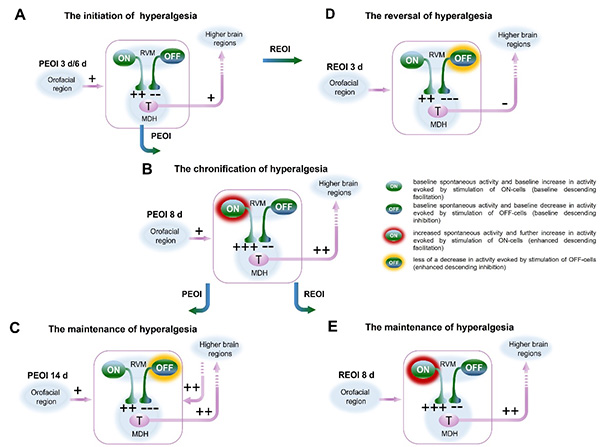Researchers Xie Qiufei and Cao Ye of the Department of Prosthodontics reported new findings on the mechanisms of orofacial pain in the Journal of Neuroscience
Recently, researchers Xie Qiufei and Cao Ye of the Center for Oral and Jaw Functional Diagnosis, Treatment and Research, Department of Prosthodontics, Peking University School and Hospital of Stomatology, have published an article entitled “Neuronal activities in the rostral ventromedial medulla associated with experimental occlusal interference-induced orofacial hyperalgesia” in “The Journal of Neuroscience”. This study provides an in-depth analysis of the mechanisms of rostral ventromedial medulla (RVM), a relay of the descending modulatory system, at different stages, and how these affect outcomes of chronic orofacial pain. The study also revealed the dynamic roles of RVM ON- and OFF-neurons in the development of chronic orofacial pain.
Chronic orofacial pain is one of the most difficult ailment to treat clinically. A considerable proportion of patients suffer from chronic orofacial pain throughout their entire lifetime, despite the therapies given or removal of potential etiological factors. There is a dire need to prevent orofacial pain from developing into chronic pain, but the mechanisms of the development of chronic orofacial pain is still unclear.
The research group has been committed to studying the mechanisms of orofacial pain for many years and established a rat model of chronic orofacial hyperalgesia induced by experimental occlusal interference (EOI), which simulates the clinical phenomenon of occlusal alteration-related chronic orofacial pain. Based on this model, two different outcomes of reversal and maintenance of orofacial hyperalgesia were created by early and late removal of occlusal interference. Through electrophysiological recording, drug microinjection in the RVM, and behavioral tests, the following results were revealed. It was found that RVM descending modulation was in a balanced state when EOI lasted for 3 or 6 days. When EOI lasted for 8 days, RVM descending facilitation was dominant. When EOI lasted for 14 days, RVM descending inhibition was dominant. At the same time, the study also confirmed that RVM descending inhibition played a dominant role in the reversal of orofacial hyperalgesia after the early removal of EOI, while RVM descending facilitation played a dominant role in the maintenance of orofacial hyperalgesia after the late removal of EOI.
In conclusion, this study suggested that the different stages and outcomes of EOI-related orofacial hyperalgesia are influenced by the adaptive changes of RVM descending facilitation and descending inhibition, which would also suggest the need for early intervention of occlusal interference-related orofacial pain.
Mo Siyi, a postdoctoral fellow of the research group, is the first author of this paper. Xie Qiufei, professor of prosthodontics, and Cao Ye, chief physician of prosthodontics are the co-corresponding authors of this paper. This work was supported by the National Natural Science Foundation of China and the Beijing Natural Science Foundation of China.
The original link: https://doi.org/10.1523/JNEUROSCI.0008-22.2022

Figure legend. Schematic diagrams depicting possible modulatory actions of ON-cells and OFF-cells in the RVM on nociceptive transmission at the MDH level at different hyperalgesia stages. T, transmission neurons. MDH, medullary dorsal horn. “+”, with peripheral nociceptive stimulus or enhanced nociceptive transmission. “++”, baseline descending facilitatory action of ON-cells, further enhanced nociceptive transmission or descending modulatory action of higher brain regions. “---”, enhanced descending inhibitory action of OFF-cells. “--”, baseline descending inhibitory action of OFF-cells.
last text: With the multi-unit cooperation led by Peking University School and Hospital of Stomatolog…
next text: Optical diagnostics and treatment of cancer mediated by protein-derived supramolecules pub…







